R.I.P. S.F.A.I.
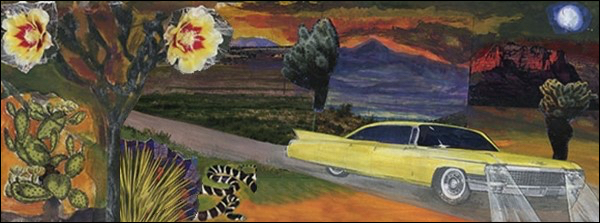
“They removed all the old trees. It looks like the sort of place you see everywhere now, with a Whole Foods and a Starbucks on the ground floor and badly made astronomically expensive condos on all floors above. Except this is a high school. Where are the kids supposed to go to smoke cigarettes? Suffice it to say that they’re never going to put a plaque out front with my name on it. Even if they wanted to, I would tell them NO. This isn’t the same place anymore. I didn’t go to school at whatever this is. I don’t know for certain if I can blame the Formica paneling, but sometimes I think a few years of looking at that day-in, day-out, could be the reason I made such a piss poor decision and went to an Ivy League Art School.”—Ted Jouflas
Desperado Shindig
By Ted Jouflas
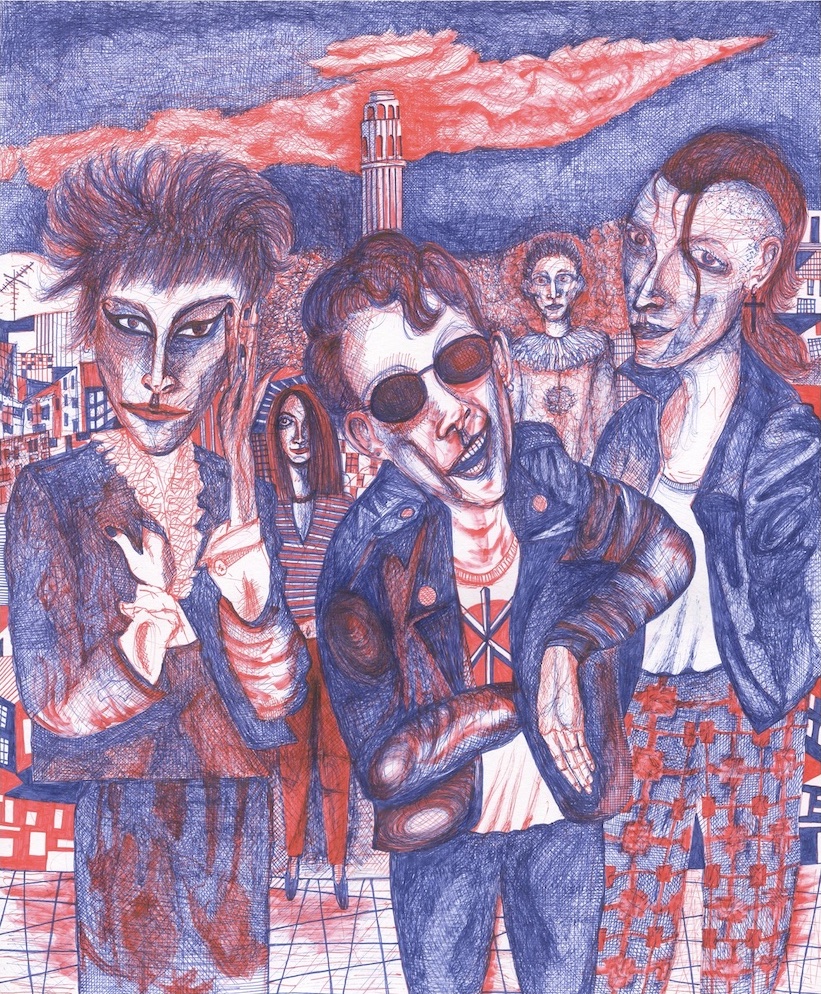
Editor’s Note: Inexplicably, between final edit and posting, the bluelines that give Mr. Jouflas’s essay even more resonance “fell out of the text.” I was out of the country, away from anything resembling wifi as we know it, and, so, we have had to wait till our November issue to restore the column to its original, intended richness.
PHOENIX Arizona—(Hubris)—September/October 2023—My Alma Maters are predeceasing me. I believe that this story was set into motion while I was still attending high school in the Rocky Mountains. The school itself was an early-20th-century building in a Victorian Gothic style, made of granite, glass, marble, wood, and brick. Five stories tall, the elegant structure was set back from a boulevard in the middle of expansive grounds with numerous large trees.
In the very center of the building was an auditorium, ensconced like a pearl in an oyster, having more in common with a small opera house than a setting for the tedious assemblies and high school plays we suffered through in there. The stage had layers of floor-to-ceiling velvet curtains, and that was exactly where some kid decided to set the fire late one night, one week before summer. They never caught who actually did it. There were rumors about a kid I knew casually. But I never heard him confess to it or deny it, either. A couple of years later, he killed himself with a shotgun, so it is too late to ask him, and he shall remain anonymous for my purposes.
Whoever they were, he or she was very clever, turning the auditorium into an internal combustion engine that spread outwards in 360 spherical degrees, thereby consuming almost everything before anyone noticed the fire. Most of us found out about it arriving for school the following morning. It was like the sulfurous ruins of Dresden. Everything inside was gone. The roof was gone; windows blown out from the heat. But the four exterior walls, made of stone, and the marble staircases, those still stood like a smoldering, wet jewel box.
The following week, they held the graduation ceremony on the football field and construction began almost immediately afterwards, rebuilding the interior.
It was the 1970s, so the new interior, when we returned to school that autumn, no longer matched the Victorian Gothic exterior. Plastic paneling lined the walls of every floor, combining into geometric patterns of Op-Art in the earthy colors of burnt orange, burnt umber, Naples yellow, avocado green, and eggshell white. The floors were no longer wooden; they were covered with hideous orange indoor/outdoor carpeting. The kind that liquid just pools up on. The kind that you cannot stain. The dissonance was shocking. From the outside, it still appeared that you might be entering a cathedral, gargoyles and all.
But once inside, you found yourself within every Mom’s tacky new kitchen.
The color scheme did, however, match the cover of Led Zeppelin’s “Houses of the Holy.” The greatness of that record could not undo the cheesiness of our new interior design, brightly lit like an airport McDonald’s, no matter how loudly you played it or how much hashish you smoked. Sometime later, in the 1990s, bureaucrats made the decision that the entire building was unsafe and should be torn down. The gorgeous exterior, along with the hideous interior (just like that cruel ballerina I once dated, realizing my folly much too late) was reduced to ruin, rubble, and the dump.
She, I mean it . . . was replaced with a schlocky mixed-use sort of building that extends all the way to the sidewalk, only three feet away from the curb on a very busy boulevard. They removed all the old trees. It looks like the sort of place you see everywhere now, with a Whole Foods and a Starbucks on the ground floor and badly made astronomically expensive condos on all floors above. Except this is a high school. Where are the kids supposed to go to smoke cigarettes? Suffice it to say that they’re never going to put a plaque out front with my name on it. Even if they wanted to, I would tell them NO. This isn’t the same place anymore. I didn’t go to school at whatever this is.
I don’t know for certain if I can blame the Formica paneling, but sometimes I think a few years of looking at that day-in, day-out, could be the reason I made such a piss poor decision and went to an Ivy League Art School.
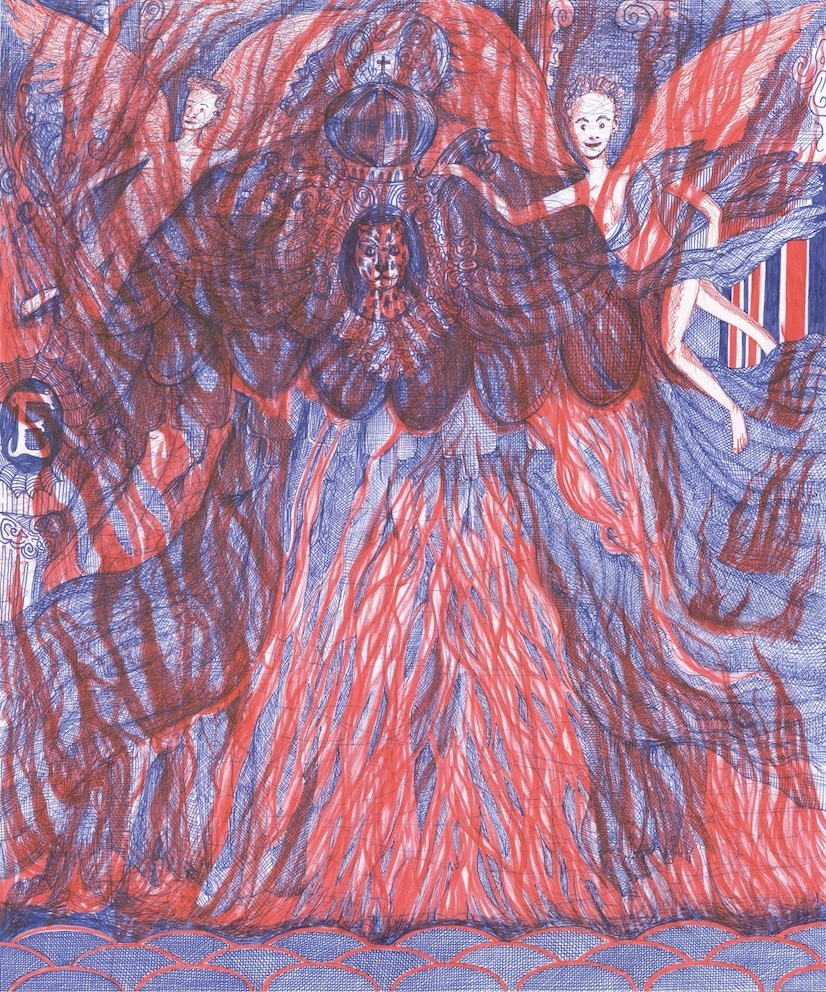
I have excellent hand eye coordination, combined with a steadiness of purpose evincing calm. A crackerjack draughtsman, I should have used my genetic gifts for something worthwhile. Like becoming a neurosurgeon. I thought about this sort of thing seriously until that afternoon during my senior year when the Human Physiology teacher took some of his class to watch a human dissection at the University Teaching Hospital.
Only five of us out of 30-something had the nerve to go. The bodies for the medical students were kept in World War Two Army barracks adjacent to the hospital. The stiffs were laid out on steel tables on wheels in two rows that ran the length of the room. There was room for a third row in the middle, which was completely empty. The medical students were busily dissecting, while periodically dousing their corpses with bottles of formaldehyde.
It was a hot June day. The last week of school. All the windows were open with big electric fans buzzing. This didn’t cool things down as much as it blew the strong chemical smells around. Soon enough, one of the girls in our group ran from the room in tears, and one of the boys threw up and fainted.
I thought neither of them will be going to medical school anytime soon. But neither would I. I could handle the gore, but I don’t like hysteria. I seriously began to consider art school, and eventually found myself at the San Francisco Art Institute during the Punk years.
In July of 2022, 40 years after I graduated, and 151 years after its founding, the oldest art school in the United States west of the Mississippi permanently closed due to financial mismanagement.
This fact has engendered a whole lot of hand-wringing and gnashing of teeth from various quarters. Some of whom likely, although blindly, bear some responsibility for the demise of their clique.
Like I said earlier, when I attended S.F.A.I., the popular sub-cultural youth movement was original Punk. This also happened to be the exact historical time that popular culture had completely penetrated high culture, like a hoodlum at a debutante ball. I was a painting major at a time when the faculty of the painting department was actually excellent. In addition, the student body was utterly punked out, or perhaps I should say faux-punked.
Both sides of my family were 20th-Century immigrants, so this was the first time in my life, in fact the only time, where I was surrounded by wealthy children. This isn’t to say that there were zero authentic punks at the institute, although the word “institute” would seem to preclude it.
Some of my classmates were members of the seminal band “The Avengers.” And there was a symbiotic relationship between most San Francisco punk bands, S.F.A.I., and the venues where these groups performed. Street punks and art punks co-mingled in a miasma of fashion, drugs, Dada-esque anger, and money. In some cases, an awful lot of money. I recall a very late-night, early- morning walk home from a Flipper gig at Valencia Tool and Die with half a dozen or so fellow students, when one of the trust-fundiest, a fellow sporting a Bow Wow Wow Mohawk noticed something twinkling in the gutter near the curb. Seizing it, he slapped it right onto his wrist, delightedly exclaiming, “A tennis bracelet! I found a diamond tennis bracelet!” His joy at this discovery bent a young woman I was fond of straight out of shape.
A young woman who had changed her name to that of a kitchen appliance.
I must say she was even lovelier when furious, as she unsuccessfully tried to snatch his prize and wear it herself. Coming from an immigrant family, I had been working in some fashion or other since childhood. Mowing neighbors’ lawns, paper route, etc. Eventually getting my Social Security Card at 15 and landing a part-time job as a dishwasher in a Chinese restaurant for the minimum wage of $1.60 per hour. So, it was shocking to discover that most of my fellow students at S.F.A.I., people in their 20s, had never had a job.
I had managed to gain entrance into those hallowed halls via a scholarship, student loans, and the work-study program, which gave me a job at the school, where I was employed 20 hours per week working for the Director of Exhibitions. There were three galleries in the school. Emmanuel Walter Gallery, Athol McBean Gallery, and Diego Rivera Gallery. The first two were for international exhibitions of contemporary art, while the third, the one with the famous fresco mural, was for student exhibitions. While working in the Exhibitions Department, I picked up all kinds of art handling skills and connections to the commercial galleries and museums in the Bay Area that eventually brought me a lot of freelance work at those other institutions.
The Director of Exhibitions at that time was a very easygoing and fair-minded woman with a young son. She was previously married to an internationally famous performance/video artist who also happened to be the father of her child. Because of this, she was still very well connected to that community of artists in the international blue-chip sense, so some of these performance/video artists had shows while I was working there, and it was astounding the stuff that these guys got away with.
It was the art world version of dealing with Van Halen, or something.
The artists’ demands were ceaseless and weird, plus they played Casanova with the receptionists. As at all art galleries, there were pretty, young receptionists, who, in this case, also happened to be graduate students. Every time there was going to be an exhibition of some big shot performance/video artist, the Director would warn the receptionist to avoid being seduced: a sort of look-at-what-happened-to-me kind of sermon, in the attempt to protect these young and naïve creatures from bogeymen. It didn’t work.
In retrospect, I think these young women decided that becoming the girlfriend of an Art Star was a faster track to their own art career than muddling about getting their MFA, and then maybe, just maybe landing a teaching gig at a university in some Podunk place far removed from New York. And that was what might happen if they were lucky.
More likely, they would wind up just like me. I completely understand why they did this, but God damn it, was it ever irritating!
The first one skedaddled with the late Chris Burden. You know, the guy who had a marksman shoot him in the left arm with a .22 rifle as a performance piece titled “Shoot.” By the time of the exhibition I worked on, he must have calmed down somewhat, his piece being a complex installation. The second one disappeared with the late Vito Acconci. Another guy who got famous in the early 70s doing transgressive things like biting his own naked body so hard that he wounded himself in a performance titled “Trademarks.”
Again, by the time of the exhibition I worked on, his work was a complex architectural installation with schematic drawings. Things that rich people could buy. I didn’t mind seeing the back of the first one because she was pretentious and extremely difficult to work with.
The second one I felt differently about. In fact, I actually worried about her for a bit. A quite pretty and demure woman with porcelain skin, jet-black hair in a pixie cut, and blue eyes. She had the thrift store chic down to a science, and had perfected the ruined party dress couture that Courtney Love would popularize years later.
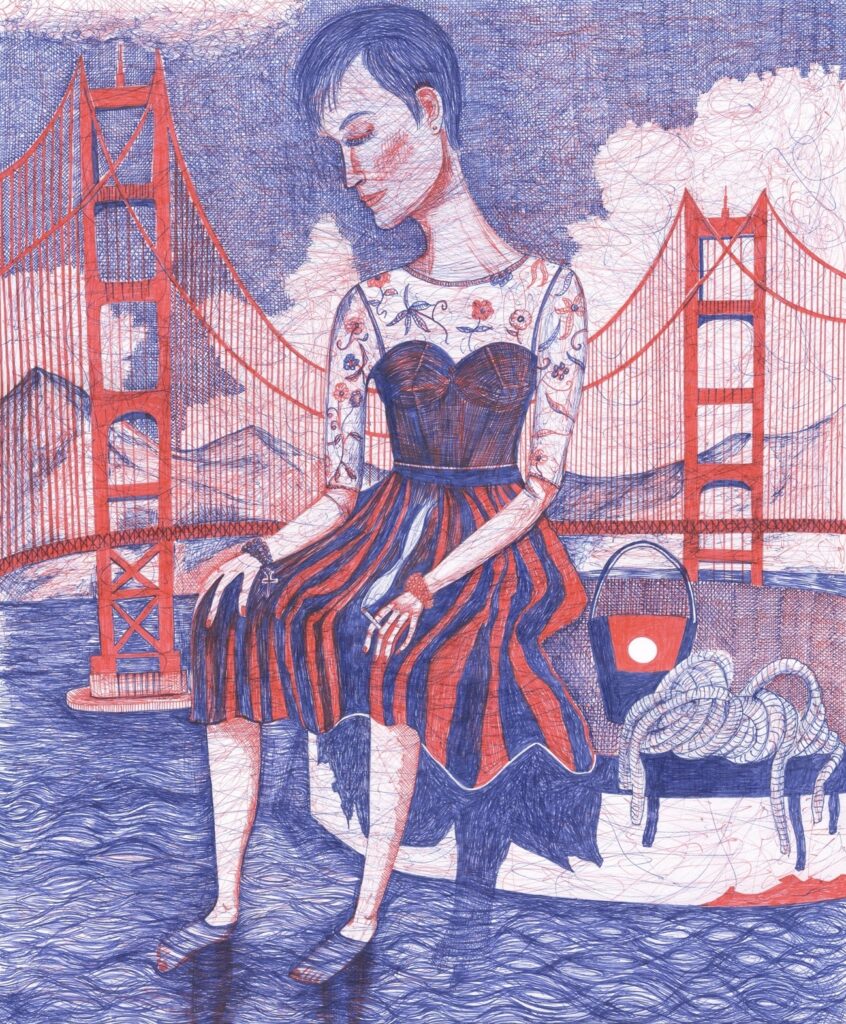
She was engaged to a medical student at Stanford. So, even though I really enjoyed her company, I kept my distance, although it was plain to see that she was no doctor’s wife. But eloping with a performance/video provocateur made even less sense. She was a very talented and intelligent oil painter, and everyone knew, in those days at least, that performance/video artists hold painters and especially oil painters in contempt.
There was this one guy who was a performance/video and film graduate student that I would see from time to time in the school restaurant or at Punk nightclubs. I have no idea what sort of horror might have befallen him, or if he was born in his current condition. Confined to a wheelchair and dressed like Dave Vanian of the “Damned,” he was also mute and communicated using a dowel rod which he held in his mouth to spell out his words with the Ouija Board that sat upon his lap. He was always accompanied by an entourage of several stylishly dressed Punk women, who to my knowledge, were not students.
He was obviously intelligent and disciplined. When it came time for the annual MFA Thesis Exhibition, his work was an X-rated erotic film starring his constant companions, and, of course, himself! I instantly admired him more than I ever had from afar. The pluck, the sheer audacity of his worldview, the humor, and the refusal to mope could only be inspirational.
Especially to a young man like me, who was having difficulties finding a girlfriend. Perhaps being a painting major was a poor choice after all. Was it because I was constantly dressed in clothes soiled with oil paint, and reeking of stand oil? I do see how being an oil painter is simply a single step removed from a grease monkey, and that a mechanic cuts no ice amongst the ruling elite. An oil painter actually presents as worse, because daughters of the elite might actually need a mechanic once in a while. Whereas an oil painter hanging around the house will only ruin the French silk upholstery while leaving grubby handprints on everything else he touches. Being a painter was definitely a retrograde ambition. Perhaps those performance/video artists were onto something . . . they certainly didn’t have to work as hard to receive Punk rock star adoration.
I had made my bed, like a lost and crazy dog walking in circles, scraping imaginary autumn leaves up off a worn burnt orange shag carpet in a corner of the painting department.

One thing you could say about the painting faculty is that they were actually formidable artists, unlike the performance/video faculty’s denizens of callow wankers. I got to study with some major contenders during my time at S.F.A.I.
The late Robert Colescott was at that time ascendant, being recognized as an international artist. A World War Two Veteran who stayed in France after the war so he could study with Ferdinand Leger, he was an excellent teacher and, if you demonstrated seriousness and dedication to being a painter, he was also a friend. At the time, his studio was a former furniture store in Oakland, and some of us were invited over from time to time to have drinks and see his work in progress. His critiques were tough-minded, but were exactly what young artists need.
M. Louise Stanley, another wonderful Bay Area Painter with an original and quirky figurative vision, was another teacher. One of the forerunners of the so called “Bad Painting” movement, she is a narrative painter who is like a writer of short stories both comedic and tragic and has created a body of literary visual work that is personal, sincere, and unique. She is also an incredibly fun person to spend time with.
The late Sam Tchakalian, who was Chair at the time, was a force not unlike the Tasmanian Devil in an old Warner Brothers cartoon. A controlled maniac in his painting strategies and in his teaching techniques, he was a blessing to know.
Making giant paintings with a ton of oil paint and squeegees, he conjured and invented a way of processing existential art that Gerhard Richter later and after the fact got famous for. His studio on Duboce Street was a huge former sweatshop where seamstresses had sewn dress shirts.
It was the largest live-in art studio I have ever seen. It was a factory.
The first time I met Sam, he was unloading a gigantic mid-century Cadillac out in front of the school on Chestnut Street. The cavernous trunk was filled with old store mannequins and various other detritus that was going to become a stage set for the model in a life drawing class.

Approaching him I said, “I like your car.” He replied, “No one around here likes my car! What are you?!” Gazing at the fins on his highway speedboat I said, “I’m a new painting student.”
Getting cross with me, his retort was, “No Motherfucker, I don’t mean what are you in a temporary sense. I mean what the fuck are you all of the time, you Motherfucker?!!” All of this time he was unloading the trunk and making a pile of mannequins on the asphalt in the gutter. I noticed that the Cadillac was parked diagonally across three-and-a-half parking spaces. I hadn’t answered quickly enough and, with annoyance, Sam queried me again: “WELL?!”
Without thinking about it, I blurted out the answer to his existential question: “I’m Greek.” At that moment, I realized that to someone driving by it could appear as though we had run down a group of pedestrians and were trying to think of what to do next. A couple of suspicious looking swarthy characters up to no good on Russian Hill. Looking straight at me he exclaimed, “I knew it! Only a Goddamn Greek would compliment this car! Well, El Greco, you’re the only one of your kind around here, and I’m the only Armenian! GREEK! Help me carry this junk into the drawing studio by the courtyard fountain, and you will do it right now, you Motherfucker!” So, I did.
Sam had the mind of a Zen Master and the mouth of a sailor. Armenians and Greeks share a mystical and existential reality, as both cultures have been the victims of genocide at the hands of Ottoman Turks. We don’t talk about it, but we know each other’s histories and it is understood.
Sam had the extra complexity of being a child of the Armenian diaspora who was born in Shanghai, lived through the Japanese Occupation in World War Two, and escaped from the Chinese Communists in the late 1940s, landing in San Francisco. After giving me a nickname the first time I met him, he never called me anything else. It was always “Greek!”
He gave the best critiques I have ever been a witness to. He could go around the room from one student’s painting to the next, performing a soliloquy for over an hour. It was sometimes brilliant, sometimes rough. He would praise here, attack there, while referencing history, art history, and the importance of chopping away at it until you revealed yourself. It was too much for some students, making them cry. I enjoyed it because he made me a better painter. The experience was no worse what I’d heard from the coaches I’d known as a competitive swimmer. I was used to trash talk as a form of camaraderie and affirmation.
There were two brothers from Brazil who were painting majors, and one night when I was alone in a drawing studio one of them came into the room. It was a large room with approximately 40 large drawing tables surrounding a large empty space in the center for the sets and life drawing models. I was using one table to work on a single large drawing. Upon entering the room, the Brazilian began to place a large sheet of Arches French Paper on every single available table.
Then he started going back and forth bringing in more art supplies. Many jars of acrylic paint, bottles of Rhoplex, oil pastels, chalk, charcoal, numerous brushes, and sticks. Then he got down to work. Pouring, splashing, scribbling, pounding, slathering, making his way around the room on both sides of the tables, over and over again, working on his dozens of pieces of paper.
I stayed where I was before he came in, working on my single drawing.
Several hours passed before he finally exhausted himself. He had just gone through a couple of thousand dollars’ worth of art supplies and didn’t have anything to show for it, except that his parents were rich.
All semester long, he had been working on a single huge painting with no direction as to what he should do with it. When I say huge, I do mean it. He had stretched a canvas that was at least ten feet vertical by twelve feet horizontal. He was painting with acrylic, and because it dries so quickly, he was able to slather the paint on quite thick. Day after day, he kept at it, making a brand-new awful painting on top of yesterday’s horrid painting.
He was going through every art historical modernist style of abstraction over and over again. Piling it high. In every single critique, Sam told him that his painting was a turd and that he should flush it! But the kid was having none of it, he was going to make it work. Days, weeks, months passed, and he couldn’t let go of it. He kept on painting over what he had painted before until the thing was so thick with paint it looked as though it had got in the way of a mudslide.
Then, one day, I was walking on this large ramp that hangs above the sculpture department. I was approaching Sam and I could see him looking down at something below. The sculpture department was always noisy due to power tools, but on that day, there was a horrible din that was very high- pitched and grinding loudly. Sam spied me and yelled over the noise, “Greek! you’ve got to see this! You won’t believe your eyes! Just look at what that crazy fucker is doing right now!”
Looking down over the edge I saw the kid from Brazil attacking Jumbo the Mess with a large handheld belt sander. He had managed to drag the thing all the way from the painting department to show it who was the boss. We stood there watching him, perplexed and slightly bemused until Sam decided to yell down to him, “Listen, you jackass! I told you to flush that turd a long time ago. If you dare bring it to my critique one more time, I swear that I will fuck it up right in front of your blind eyes! You better not bring it, or you will be fucking with me!”
His ordeal finally ended: the next day the kid was stretching a brand new enormous canvas. While I was studying there, S.F.A.I. had an endless parade of visiting artists who were interesting and fun to meet: David Hockney, Wayne Thiebaud, Annie Leibovitz, Susan Rothenberg, Roger Herman, Michael Lucero, Cheryl Laemmle, William S. Burroughs, Laurie Anderson, Joan Brown, Manuel Neri, Nicolas Africano, and many others.
One day, during my final semester, I had an epiphany during a class critique. I had been daydreaming in boredom when it occurred to me to count the students in ratio to the professor. Then I extrapolated those numbers across the school, and then again across every art department in every university in the land.
It was only an educated and approximate guess, but it wasn’t a pretty picture. The odds of landing a teaching position, even at a school where you wouldn’t want to teach, in a place where you wouldn’t want to live were nil, next to nothing. Sure, the trust fundamentalists were going to be fine, aging badly for the rest of their lives. But for students who were from middle-class families who had to work, or for someone like myself from an immigrant family that had barely gotten a toehold in America, the outlook was pretty bleak.
Per usual, mathematics, which is everything, had shown me that I was an idiot.
It makes sense that an institution that existed mainly for wealthy children would boast about housing a large fresco mural painted by the communist propagandist Diego Rivera. Phonies live everywhere. I’ve seen those twin houses, one of them blue, connected by a bridge, where he resided with his wife Frida Kahlo, who was by far the better artist, keeping it personal.
And that is only one of their estates. The will to power is great, especially for those who are bossy, and communism is a most excellent racket for getting rich quickly: it is, after all, nothing but a materialistic philosophy.
Apparently, there is a big old fuss going on about what to do with this giant wall of a picture currently valued at fifty million dollars ($50,000,000.00). Perhaps the bankruptcy lawyers can sell it to one of the Silicon Valley Billionaires. Add another room onto the smart mansion and it could make a quaint and cute conversation piece.
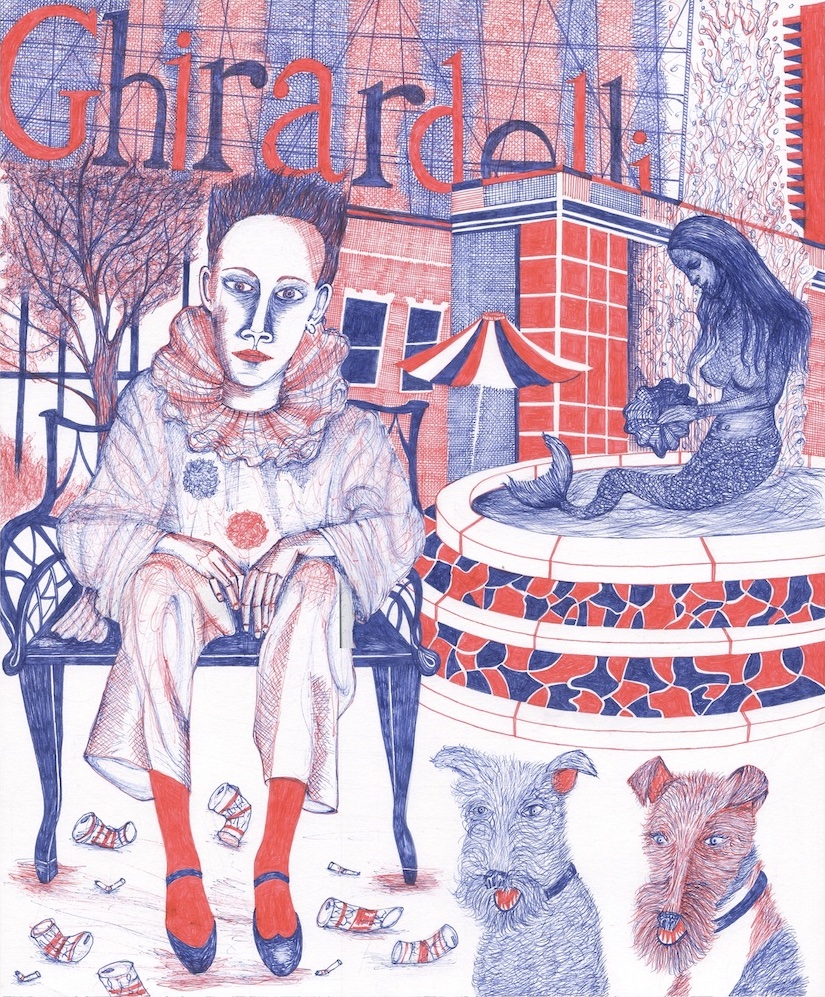
All swindles must end sometime and so it goes with S.F.A.I. I graduated in 1982, 40 years before the big kaput. I walked away with my diploma, five figures in debt to Chase, and the ability to acquire the exact sort of employment as if I had graduated High School and never gone to university at all. After a period of working for temp agencies and freelance art crating, I managed to land a full-time job at a one-hour photo joint owned by a Mormon family on the main drag at Fisherman’s Wharf.
The boss was a German immigrant in his late thirties who had a degree in photography from the Universität der Kunste Berlin. We liked one another and had a lot in common. But he was absolutely furious at his fate and was tantrum-prone towards unreasonable customers, adding a much-needed element of comedy to our shared ordeal.
The architecture this business resided in was a large glass bubble, which gave the room the ambience of a laboratory displaying all of the equipment and machinery required to develop color film and make prints in one hour.
We were also completely on display in our toil. Like pet monkeys living in an educational reform school zoo. Tourists from all over the world gawked at us all day long as we developed their photos of themselves at Fisherman’s Wharf in San Francisco. If you want to get conceptual art school about it, this was the analog version of the selfie. Only they had to wait too long for their dopamine so they got testy, and when they got too testy Karl would yell at them.
So, there I stood for eight hours a day in a glass bubble, doing a bullshit job, and suddenly I realized that I had finally made it as a performance artist.

One Comment
Daniel Dodson
Thanks. Excellent storytelling and a fun ride through the era..
It is poignant to remember how wealthy a fifteen year-old felt just washing dishes afer school.
Of course, at 13 we lied and claimed to be 14 (to wash dishes)
-and at 14 we lied and claimed to be 16 to bag groceries.
Bluster and a Social Security Card was all that was required for adolescent enterprise (and the purchase price of Mr. Natural memorabilia).